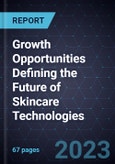Demand for Ingredients with Proven Efficacy and Clinical Evidence Drives Advances in Skin Brightening and Anti-aging Product Segments
The skincare industry is evolving, with stakeholders looking for new ingredients with established biocompatibility and proven efficacy for skin lightening and anti-aging and those in the exploratory stage. Ingredients such as hyaluronic acid, phytoextracts, vitamins, antioxidants, AHAs, and probiotics are emerging as promising actives capable of healing the skin or inhibiting melanogenesis for anti-aging and lightening respectively, especially those that naturally occur or require minimal processing. R&D teams of personal care companies seek to speed up extraction and processing of plant and marine-based actives as well as expand the potential of ingredients like hyaluronic acid, which can act as a molecular sponge holding up to 1,000 times its weight in water for skin hydrating and anti-aging benefits. Researchers test probiotics and genobiotics for their ability to restore skin pH, reduce oxidative stress, and combat the effects of sun damage from UV light. Amino acids and peptides, coenzyme Q10, botanical and marine ingredients, and vitamins are other ingredients also gaining traction in the market.
To answer whether these ingredients represent the future of sustainable skincare requires companies to adopt biotechnology processes and fermentation processes that do not compromise efficacy. Companies are investigating simulation or mimicking natural processes in a fully controlled manner using plant, microbiological, or cellular-based ingredients. Skincare companies also leverage technology licensing and partnerships with research institutes and start-ups to develop ingredients that can bridge the gap between science and traditional medicine.
The study sheds light on technology and industry trends, stakeholder ecosystems and technical aspects of emerging ingredients, and viable growth opportunities for developing skin brightening and anti-aging product segments.








